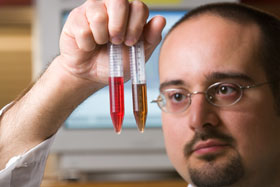  |
| HOME | THIS ISSUE | CALENDAR | GRANTS | BACK ISSUES | < BACK | NEXT > |
Animal science professor researches chemistry of meatby Kenneth Best - September 11, 2006 |
||||
| When Richard Mancini goes to the meat counter at the supermarket, he brings more than just a shopper's eye for bargains. He brings the perspective of a researcher who has published 15 studies on various aspects of meat science in scientific journals. Mancini, a 1999 graduate of the College of Agriculture and natural Resources, returned to Storrs last year as an assistant professor of animal science, after earning a master's degree in meat science and a doctorate in food science at Kansas State University. He teaches classes in animal food products and meat processing, while also serving as manager of UConn's meat science and sensory laboratories. "A better understanding of the chemistry of meat will help the consumer from a food safety point of view," he says. "I think if we can better understand fresh and cooked meat, we can help the meat industry to improve the safety of its product." When he first arrived at UConn as a student, Mancini had experience with meat science through the Future Farmers of America and from butchering pigs and pig carcasses at home. He expressed his interest in learning more about the subject to Cameron Faustman, a professor of meat science, who became his mentor. "I think there is a great sense of pride to know that a student got turned on to a subject while they were here," says Faustman, now associate dean of the Ratcliffe Hicks School of Agriculture, "went on to graduate school, and then came back home." Mancini's research includes factors affecting the shelf-life of beef and pork; meat packaging; meat chemistry; and value-added meat products. "It's of big interest to the meat industry and to retailers if we can improve the shelf-life of the products," he says, noting that there are two systems now used in the industry to provide fresh meat to consumers. Most local supermarkets receive pieces of meat of between 15 and 20 pounds that can be cut up into steaks and chops by a butcher at the store and packaged for consumers.
Some larger stores receive pre-packaged meat from the processing plant. "In a typical supermarket, the shelf-life can range from one day - for an expensive cut like filet mignon - to several days, depending on the cut of meat," he says. "Aging has also shown to improve tenderness and give the meat a more beefy flavor. When it is aged, enzymes break down the proteins that give structure to the muscle of the meat." When teaching classes, Mancini says he combines information and hands-on activities, such as how to cut and package meat, with science, such as why meat is red: the color comes from a small globular protein, similar to the hemoglobin that gives human blood its red color. In his meat products class, for example, the laboratory portion includes butchering techniques for beef, pork, and lamb carcasses. "The students get to see a whole carcass down to a pork chop or steak," Mancini says. "We make hams, bacon, and sausage. And we always cook up the sausage on the grill." Students who have taken Mancini's classes may pursue a career in research and development for a food industry company, such as Tyson or Hormel. Others may go into the field of agricultural education. Mancini says that, when shopping, he tries to be a wise consumer: "I see the cost-saving of buying a large piece of meat and cutting it up myself, but I also shop for bargains," he says. "If it's priced right and cut up already, I'll buy it." |
| ADVANCE HOME UCONN HOME |

